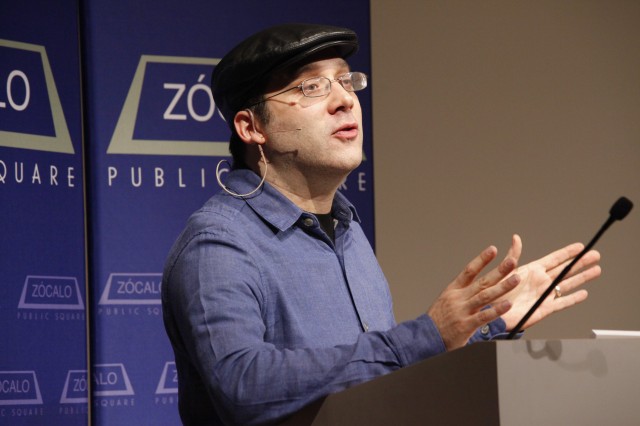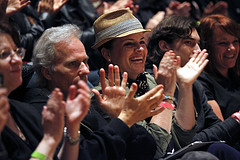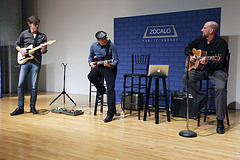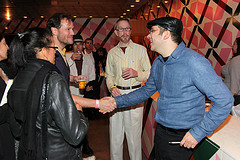
What inspired an accomplished scientist with no known musical aptitude to learn to play guitar just before turning 40? At an event co-presented by Kaiser Permanente in front of a large crowd at MOCA Grand Avenue, and with some musical assistance from two local guitarists, New York University psychologist Gary Marcus, author of Guitar Zero: The New Musician and the Science of Learning, explained how he learned to play the instrument, what it taught him about the process of learning, and how our bodies and brains experience music.
It all started with what Marcus called “the dumbest video game on the planet”: Guitar Hero. It’s a game that’s “very easy for ordinary people,” said Marcus, “but for people with rhythmic impairments it’s not so easy.” All the game requires is pressing the right button at the right time as colored dots slide down the screen. Yet the game was torture for Marcus, and even more so when the virtual crowd started booing. (“I became very familiar with that phenomenon,” he said.)
Marcus discovered he had no sense of rhythm when he tried to learn the recorder in fourth grade. “Mary Had a Little Lamb,” said Marcus, “became my Waterloo very quickly.” His teacher dropped him after just two lessons.

This time around, things were different. With some encouragement and feedback from his wife, Marcus got better at Guitar Hero, eventually making it all the way through Foghat’s “Slow Ride” without the crowd booing. The game was a “gateway drug” to the real thing: “I decided I was going to spend the last two weeks of the summer trying to become musical,” said Marcus. “I practiced for six hours a day, and by the end of the two weeks, I sort of started to sound faintly musical.”
Marcus studies how children learn language and explained that scientists used to think there was a “critical period” during which children must acquire certain skills–either before age three or before puberty. But they later discovered this wasn’t set in stone and that it is possible for adults to acquire languages later in life.
Marcus was struck by Stanford biologist Eric Knudsen’s studies of barn owls, who navigate in the dark by using an internal map of the visual world. Knudsen distorted the perception of a group of owls by 23 degrees with a prism. The younger owls adjusted easily, but the older owls were unable to adapt. However, in a later study, when the older owls’ perception was adjusted incrementally, by just six degrees at a time, they too were able to make the same adaptation.

Marcus applied this idea to his guitar practice, focusing on learning just one or two chords at a time. He approached the guitar from an engineer’s perspective, trying to understand what made learning difficult.
Marcus spoke with guitar teachers about strategies that worked with their students. A Suzuki Method teacher told him that practice at home is more important than what happens in the classroom. She tells parents not to correct their children until they’ve made the same mistake three times, in order to create an environment where children and parents aren’t at odds. Another teacher told him that she has her students play the songs in their head on the subway away from their instruments–and to start from the middle of the song rather than the beginning so they can develop a sense of where they’re getting stuck and overcome any difficulties.
At a rock ’n’ roll summer camp where Marcus played with 11- and 12-year-olds, he discovered that although the kids were faster on their fingers, he had the advantage of knowledge gleaned from listening to music over many years.
Before the question-and-answer session, Marcus joined fellow guitar players Barrett Tagliarino–who had opened the evening by playing two songs solo–and Greg Bryant for a brief jam session. An audience member asked how long it had taken Marcus to learn the song. It was an improvisation, he replied–so either three minutes (about the length of time they’d rehearsed earlier in the day) or three years (Marcus’s total guitar experience).

The audience also asked Marcus how music impacts his mood, and what he discovers about his body, and the mind-body connection, when he plays.
Playing music “definitely puts [my mood] up,” said Marcus, who thinks people listen to and play music as a form of self-medication. Guitar has also made him much more aware of his body. For the first time in years, he’s riding a unicycle again–and he’s better than he was in college, he thinks, because he’s more aware of his body thanks to the guitar. In addition, guitar teaches you better posture–and improves your rhythm. At a wedding a few months ago, Marcus even managed to dance in time with the music. “For the first time in my life, people actually complimented me on my dancing,” he said.
There’s also a rush that comes from learning something new on guitar–the same “joy of discovery” and hit of dopamine that Marcus experiences when he learns something new in science.
But he cautioned that adults can be their own worst enemies when it comes to learning a new skill. “Older people have to cut themselves slack and often don’t,” said Marcus. They want to sound like Santana the first time out, whereas kids can enjoy the process rather than focusing too much on the end result.
Watch full video here.
See more photos here.
Buy the book: Skylight Books, Amazon, Powell’s.
Read music and gaming experts’ opinions on what we’ve learned from Guitar Hero here.
Read more from Kaiser Permanente on how music can improve mood here.
*Photos by Aaron Salcido.




Send A Letter To the Editors